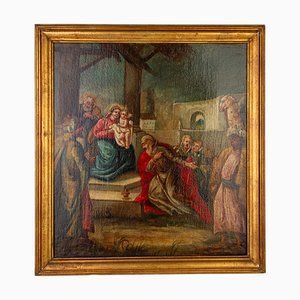Albrecht Dürer 16th Century Old Master Engraving The Sudarium Of Saint Veronica Good condition overall, framed and mounted under protective glass. Dated and signed in the plate with the artist’s monogram on a tablet lower center. A clean & clear 16th century Meder “c” (of d) impression, printed after the appearance of the scratch in the shadow under the arm of the angel on the right. Catalog: Bartsch 25; Dodgson 71; Panofsky 132; Meder 26b; Hollstein 26; Strauss 69; Schoch/Mende/Scherbaum 68. Literature regarding this artwork: Giulia Bartrum, Albrecht Dürer and his Legacy: The Graphic Work of a Renaissance Artist, The Britsh Museum Press, 2002, no. 4, p. 82 (ill.) Collections in which impressions of this state of this engraving can be found: Museum of Fine Arts (Department of Prints and Drawings), Boston; Staatliche Graphische Sammlung, Munich. Few Christian legends are better known and more valued than that of St. Veronica, who compassionately wiped the face of Jesus when He fell beneath the load of His cross on the way to Calvary. Nor is that to be wondered at, for it is a most touching story that appeals at once to the heart of every Christian and, in the version which makes her the wife of a Roman officer, is a moving example of contempt of public opinion and human respect. But the legend, though ancient, has only a vague tradition to support it, and the identifications of the woman to whom the name Veronica has been given are several and various. Dürer had worked intensively during the years up to 1513 on his series of Passion woodcuts, but the natural association of this engraving with the prints of the Engraved Passion, to which it would form an appropriate tail-piece, is precluded by the unusual horizontal format. Dürer himself viewed it as a single sheet print, since he refers to it as Veronicum in his diary of the journey to the Netherlands. On two occasions in August of 1520 he gave impressions away as presents. However, the most striking feature of the print, as subsequent artists such as Dürer’s follower Sebald Beham noticed and many commentators have indicated, is the similarity of the frontal gaze of Christ to Dürer’s self-portrait of 1500 in Munich. As the scholar Panofsky noted “the features of the Savior bear an unmistakable resemblance to Dürer’s own.” It is one of numerous occasions that Dürer associated the idea of his image with that of Christ. Giorgio Vasari’s of the self-portrait painted on cambric, which the artist sent to Raphael as a gift in about 1515, bears a curious resemblance to the idea of St. Veronica’s sudarium..
Albrecht Dürer Incisione antica del XVI secolo Il Sudario di Santa Veronica In buone condizioni generali, incorniciata e montata sotto vetro protettivo. Datata e firmata nella lastra con il monogramma dell'artista su una tavoletta in basso al centro. Impressione "c" (di d) pulita e nitida di Meder del XVI secolo, stampata dopo la comparsa del graffio nell'ombra sotto il braccio dell'angelo a destra. Catalogo: Bartsch 25; Dodgson 71; Panofsky 132; Meder 26b; Hollstein 26; Strauss 69; Schoch/Mende/Scherbaum 68. Letteratura relativa a quest'opera: Giulia Bartrum, Albrecht Dürer e la sua eredità: The Graphic Work of a Renaissance Artist, The Britsh Museum Press, 2002, no. 4, p. 82 (ill.) Collezioni in cui si trovano impressioni di questo stato dell'incisione: Museum of Fine Arts (Department of Prints and Drawings), Boston; Staatliche Graphische Sammlung, Monaco. Poche leggende cristiane sono più conosciute e apprezzate di quella di Santa Veronica, che asciugò compassionevolmente il volto di Gesù quando cadde sotto il peso della croce sulla via del Calvario. Non c'è da stupirsi, perché è una storia molto toccante che fa appello al cuore di ogni cristiano e, nella versione che la rende moglie di un ufficiale romano, è un esempio commovente di disprezzo dell'opinione pubblica e di rispetto umano. Ma la leggenda, per quanto antica, ha solo una vaga tradizione a sostegno, e le identificazioni della donna a cui è stato dato il nome di Veronica sono diverse e varie. Dürer aveva lavorato intensamente negli anni fino al 1513 alla serie di xilografie della Passione, ma la naturale associazione di questa incisione con le stampe della Passione incisa, di cui costituirebbe un'appropriata coda, è preclusa dall'insolito formato orizzontale. Dürer stesso la considerava una stampa in un unico foglio, dato che la cita come Veronicum nel suo diario del viaggio nei Paesi Bassi. In due occasioni, nell'agosto del 1520, regalò le impressioni. Tuttavia, la caratteristica più evidente della stampa, come hanno notato artisti successivi come Sebald Beham, seguace di Dürer, e molti commentatori hanno indicato, è la somiglianza dello sguardo frontale di Cristo con l'autoritratto di Dürer del 1500 a Monaco. Come ha notato lo studioso Panofsky, "i lineamenti del Salvatore hanno una somiglianza inconfondibile con quelli di Dürer" È una delle numerose occasioni in cui Dürer ha associato l'idea della sua immagine a quella di Cristo. L'autoritratto dipinto su cambric, che l'artista inviò in dono a Raffaello nel 1515 circa, presenta una curiosa somiglianza con l'idea del sudario di Santa Veronica.




















Contattaci
Fai un'offerta
Abbiamo notato che sei nuovo su Pamono!
Accetta i Termini e condizioni e l'Informativa sulla privacy
Contattaci
Fai un'offerta
Ci siamo quasi!
Per seguire la conversazione sulla piattaforma, si prega di completare la registrazione. Per procedere con la tua offerta sulla piattaforma, ti preghiamo di completare la registrazione.Successo
Grazie per la vostra richiesta, qualcuno del nostro team vi contatterà a breve.
Se sei un professionista del design, fai domanda qui per i vantaggi del Programma Commerciale di Pamono